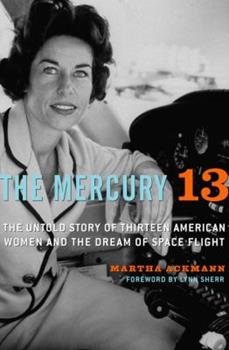 Since March is Women’s History Month, I thought I would write this blog post about some courageous women pilots who have been largely forgotten by time and are not widely recognized today. I am referring to the history of the First Lady Astronaut Trainees, more commonly known as the Mercury 13. This group of women were secretly evaluated to see if they might be suitable astronaut candidates for America’s first human spaceflight program in the early 1960s. The thirteen women pilots, eager to participate in the space race against the Soviet Union, were subjected to the same rigorous tests that were given to the male astronaut candidates at the time. Although the group was never an official NASA program, the excitement and commitment of these women paved the way for other women who followed.
Since March is Women’s History Month, I thought I would write this blog post about some courageous women pilots who have been largely forgotten by time and are not widely recognized today. I am referring to the history of the First Lady Astronaut Trainees, more commonly known as the Mercury 13. This group of women were secretly evaluated to see if they might be suitable astronaut candidates for America’s first human spaceflight program in the early 1960s. The thirteen women pilots, eager to participate in the space race against the Soviet Union, were subjected to the same rigorous tests that were given to the male astronaut candidates at the time. Although the group was never an official NASA program, the excitement and commitment of these women paved the way for other women who followed.
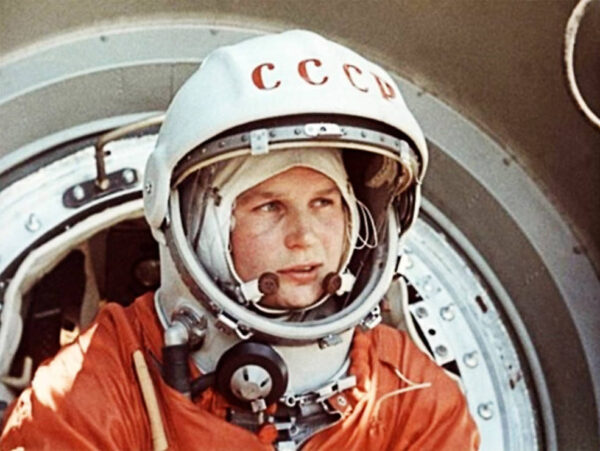 The Mercury 13: The Untold Story of Thirteen American Women and the Dream of Space Flight, a 2003 book by Martha Ackmann, chronicles the story of these women, who underwent the same medical and fitness testing that the male astronaut candidates did, in the early 1960s. While USSR Cosmonaut Valentina Tereshkova, at left, became the first woman to orbit Earth in 1963, the U.S. did not launch women for another twenty years. Tereshkova has been quoted as saying, “A bird cannot fly with one wing only. Human space flight cannot develop any further without the active participation of women.” Thus, it is striking that the Soviet Union did not launch another woman into space for about the same number of years (see Reference 2 for more details.) In any case, it turns out that the story of the Mercury 13 was a piece of history that I knew nothing about until I heard Martha Ackmann speak at NASA and read her book, which I highly recommend. As described on the book jacket, The Mercury 13 is an “unforgettable story of determination, resilience, and inextinguishable hope.”
The Mercury 13: The Untold Story of Thirteen American Women and the Dream of Space Flight, a 2003 book by Martha Ackmann, chronicles the story of these women, who underwent the same medical and fitness testing that the male astronaut candidates did, in the early 1960s. While USSR Cosmonaut Valentina Tereshkova, at left, became the first woman to orbit Earth in 1963, the U.S. did not launch women for another twenty years. Tereshkova has been quoted as saying, “A bird cannot fly with one wing only. Human space flight cannot develop any further without the active participation of women.” Thus, it is striking that the Soviet Union did not launch another woman into space for about the same number of years (see Reference 2 for more details.) In any case, it turns out that the story of the Mercury 13 was a piece of history that I knew nothing about until I heard Martha Ackmann speak at NASA and read her book, which I highly recommend. As described on the book jacket, The Mercury 13 is an “unforgettable story of determination, resilience, and inextinguishable hope.”
In 1959, NASA introduced the first class of American astronauts, collectively known as the Mercury 7. One year earlier, President Eisenhower had decided to select the Mercury astronauts from the small, familiar pool of military test pilots, which excluded women. Even though over one thousand women had flown as Women Airforce Service Pilots (WASPs) during World War II, they were considered civilians after the war ended. Subsequently, none of the U.S. military branches admitted women as pilots for decades, effectively barring women from the NASA astronaut program.
Shortly after John F. Kennedy was elected in 1960, NASA began accelerated rocket development in response to the Soviet space program. NASA flight surgeon Dr. Randy Lovelace and U.S. Air Force General Donald Flickinger became curious about a theory that there might be advantages to female astronauts. It was proposed that, since women generally weighed less than men and could conceivably use fewer resources, such as oxygen, water, and food, that this idea would be worth studying. The overall weight of aircraft and spacecraft has always been, and continues to be, a serious concern in any mission planning.
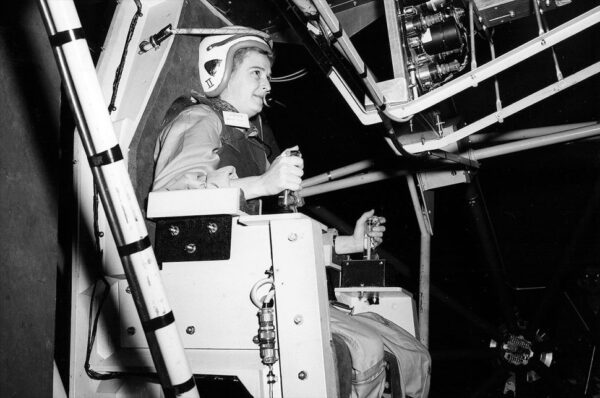 Because NASA officially admitted test pilots with college degrees into their astronaut program, Lovelace decided to perform his study in secret. The test program was privately funded by Jacqueline “Jackie” Cochran, who was a pilot and pioneer in women’s aviation. Jerrie Cobb was the first woman to be invited to the Lovelace Foundation in Albuquerque, New Mexico to undergo the first of three test phases (phase 1 – medical testing, phase 2 – psychological and neurological screenings, and phase 3 – flight simulations) given to the thirty-two male Project Mercury candidates. When she passed these early tests with flying colors, Lovelace and Cobb reviewed the records of roughly seven-hundred female pilots who also had extensive flight experience and invited 24 others to be tested as well.
Because NASA officially admitted test pilots with college degrees into their astronaut program, Lovelace decided to perform his study in secret. The test program was privately funded by Jacqueline “Jackie” Cochran, who was a pilot and pioneer in women’s aviation. Jerrie Cobb was the first woman to be invited to the Lovelace Foundation in Albuquerque, New Mexico to undergo the first of three test phases (phase 1 – medical testing, phase 2 – psychological and neurological screenings, and phase 3 – flight simulations) given to the thirty-two male Project Mercury candidates. When she passed these early tests with flying colors, Lovelace and Cobb reviewed the records of roughly seven-hundred female pilots who also had extensive flight experience and invited 24 others to be tested as well.
The Mercury 13 women all had more than 1000 flight hours (Jan Dietrich had 8,000 hours, Wally Funk 3,000 hours, Irene Leverton more than 9,000, and Jerrie Cobb more than 10,000) and were subjected to the same rigorous reviews that the men were. The thirteen women who successfully passed the first phase of medical tests in New Mexico included Jerrie Cobb, Gene Nora Jessen, Wally Funk, Jerri Truhill, Sarah Gorelick Rutley, Myrtle Cagle, Bernice Steadman, Janet Dietrich, Marion Dietrich, Janey Briggs Hart, Jean Hixson, Rhea Hurrle, and Irene Leverton. Three of the women (Jerrie Cobb, Rhea Hurrle, and Wally Funk) also completed second phase testing in Oklahoma, which included a very strenuous isolation test. Jerrie Cobb was the only woman to finish all three phases, and she scored in the top 2% of all candidates of any gender, outperforming some of the Mercury 7 astronauts. However, as details of the testing started to become known, additional phase 3 tests for the women, using equipment and facilities at the U.S. Naval School of Aviation Medicine in Pensacola, Florida, were abruptly cancelled. [Ironically, despite the importance of the data that was collected, the reports were somehow lost, and the research had to be repeated in the 1970s.]
The cancellation was very disappointing for the women, especially for Jerrie Cobb and Wally Funk, who may have been more emotionally invested than the others. Still, they were all very excited, and two of the pilots had even quit their jobs to be able to participate in the test program. Since the project was secret and most of the women didn’t know who else had participated, Jerrie Cobb took the initiative and began looking for options to try to get additional testing reinstated. Janey Hart, the oldest of the Mercury 13 women and mother of eight, was married to a U.S. Senator. Therefore, she was able to use her political savvy and connections to set up a meeting with Lyndon Johnson, who was Vice President at the time. She was working through an aide to Johnson, who drafted a letter supporting the women for Johnson to forward to NASA administrator James Webb. However, when they met, Johnson did not agree to help them and in fact wrote, “Let’s stop this now!” on the bottom of the letter.
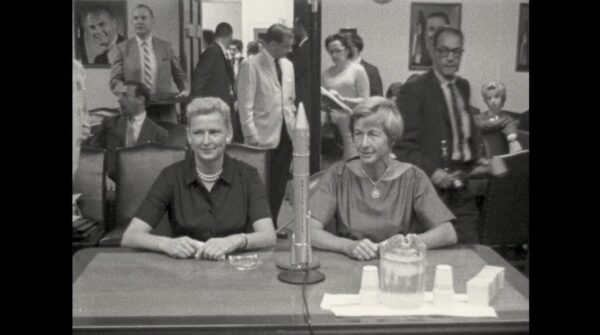 Unaware of Johnson’s lack of support and unwilling to give up, Cobb and Hart decided to appeal to Congress. Hart wrote letters to the House and Senate space committees to see if they would be willing to convene subcommittee meetings to look into the question of discrimination. She was unsuccessful with the Senate Committee on Aeronautical and Space Sciences, but the chair of the House Committee on Science and Astronautics was more interested. In June 1962, Jerrie Cobb and Janey Hart were invited to testify before a House special subcommittee that would investigate the issue. Jackie Cochran used her political influence to score a slot to testify as well.
Unaware of Johnson’s lack of support and unwilling to give up, Cobb and Hart decided to appeal to Congress. Hart wrote letters to the House and Senate space committees to see if they would be willing to convene subcommittee meetings to look into the question of discrimination. She was unsuccessful with the Senate Committee on Aeronautical and Space Sciences, but the chair of the House Committee on Science and Astronautics was more interested. In June 1962, Jerrie Cobb and Janey Hart were invited to testify before a House special subcommittee that would investigate the issue. Jackie Cochran used her political influence to score a slot to testify as well.
Ackmann’s book provides a facinating, blow-by-blow account of these July 1962 House subommittee hearings on gender discrimination at NASA. All three women who tesified were able to give their arguments for (Cobb and Hart) and against (Cochran) extending the Mercury 13 test program. Hart testified, “I am not arguing that women be admitted to space merely so that they won’t feel discriminated against. I am arguing that they be admitted because they have a very real contribution to make.” However, the committee members were most interested in the opinions of recently flown heroes John Glenn and Scott Carpenter. Glenn testified that “It is just a fact. The men go off and fight the wars and fly the airplanes and come back and design and build and test them. The fact that women are not in this field is a fact of our social order. It may not be desirable.” NASA continued to argue that there was “no requirement” for female astronauts. They had all the male test pilot astronauts they needed. Glenn argued, “Now to spend many millions of dollars to additionally qualify other people, whom we don’t particularly need, regardless of sex, creed, or color, doesn’t seem right, when we already have these qualified people.” So, in the end, the House Subcommittee agreed that there was no requirement and they actually ended the hearings early, cancelling the planned third day of hearings.
 When Soviet cosmonaut Valentina Tereshkova became the first woman in space on June 16, 1963, Clare Boothe Luce published an article in Life Magazine, criticizing NASA and and other American decision-makers who opposed the Mercury 13. Scott Carpenter would later say of the Mercury 13, “those women were before their time.” Not by much though, because only two years later, Title VII of the Civil Rights Act of 1964 would grant women a legal basis for equal rights in employment. So, for awhile the Mercury 13 remained in the minds of advocates of women’s rights. For example, I could not resist including the photo to the left. Here we see the Mount Holyoke College class of 1940, during their annual alumnae reunion parade in 1965. These women were protesting in hats and high heels, with a sign that reads, “Women Should be Trained as Astronauts!”
When Soviet cosmonaut Valentina Tereshkova became the first woman in space on June 16, 1963, Clare Boothe Luce published an article in Life Magazine, criticizing NASA and and other American decision-makers who opposed the Mercury 13. Scott Carpenter would later say of the Mercury 13, “those women were before their time.” Not by much though, because only two years later, Title VII of the Civil Rights Act of 1964 would grant women a legal basis for equal rights in employment. So, for awhile the Mercury 13 remained in the minds of advocates of women’s rights. For example, I could not resist including the photo to the left. Here we see the Mount Holyoke College class of 1940, during their annual alumnae reunion parade in 1965. These women were protesting in hats and high heels, with a sign that reads, “Women Should be Trained as Astronauts!”
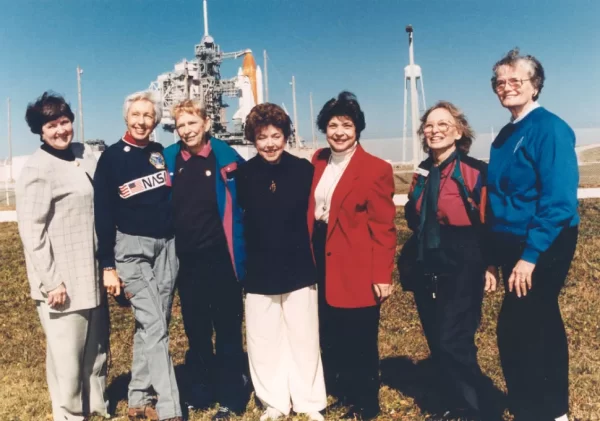 It turns out that Valentina Tereshkova was actually less qualified than the Mercury 13 and later American women astronauts, since she was not certified as a pilot or scientist. When she later met Jerrie Cobb, Tereshkova said that Cobb had alway been her role model, asking “we always figured you would be first. What happened?”
It turns out that Valentina Tereshkova was actually less qualified than the Mercury 13 and later American women astronauts, since she was not certified as a pilot or scientist. When she later met Jerrie Cobb, Tereshkova said that Cobb had alway been her role model, asking “we always figured you would be first. What happened?”
The Mercury 13 women of course celebrated when Sally Ride and the other female Mission Specialists who were recruited as astronauts in 1978. However, they were most excited when Eileen Collins, a graduate of Air Force test pilot training, flew her first mission as a Space Shuttle pilot in 1995. You can see seven of the Mercury 13 women in the photo at right that was taken in front of the Space Shuttle Discovery stacked on Launch Pad 39B for the STS-63 mission in April 1995. The women who attended the launch at Kennedy Spaceflight Center as invited guests of Pilot Eileen Collins included (from left): Gene Nora Jessen, Wally Funk, Jerrie Cobb, Jerri Truhill, Sarah Gorelick Rutley, Myrtle Cagle and Bernice Steadman. Not pictured are Janet Dietrich, Marion Dietrich, Janey Briggs Hart, Jean Hixson, Rhea Hurrle, and Irene Leverton.
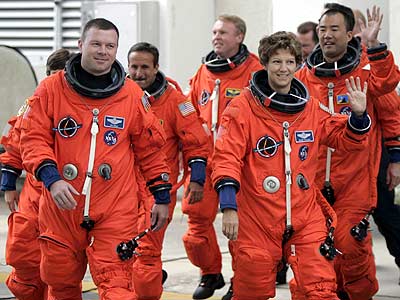 Later, in July 1999, Collins became the first woman to command a shuttle mission (STS-93,) piloting Columbia into Low Earth Orbit to deploy the Chandra X-ray Observatory. She also commanded the important 2005 STS-114 return-to-flight mission after the Columbia accident. I love this picture of Eileen at left, with her supremely confident demeanor as she walks out of the ONC building at Kennedy Space Center with her team for the STS-114 mission. She logged more than 6,751 hours in 30 different types of aircraft and more than 872 hours in space, as a veteran of four space shuttle flights.
Later, in July 1999, Collins became the first woman to command a shuttle mission (STS-93,) piloting Columbia into Low Earth Orbit to deploy the Chandra X-ray Observatory. She also commanded the important 2005 STS-114 return-to-flight mission after the Columbia accident. I love this picture of Eileen at left, with her supremely confident demeanor as she walks out of the ONC building at Kennedy Space Center with her team for the STS-114 mission. She logged more than 6,751 hours in 30 different types of aircraft and more than 872 hours in space, as a veteran of four space shuttle flights.
Still, sometimes long-chrerished dreams can finally come true. In July 2021, twenty-six years after Eileen Collins was selected to be an astronaut, Wally Funk was launched on a suborbital flight aboard Blue Origin’s New Shepard 4 vehicle, flight 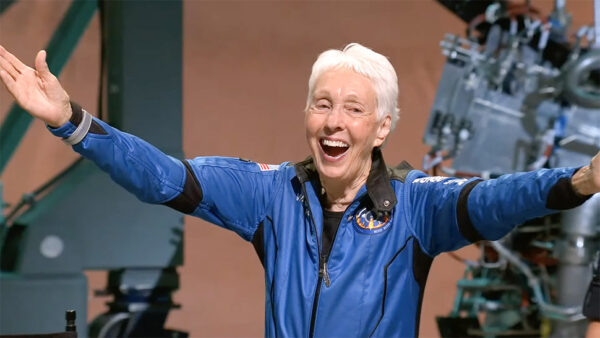 16, making her the oldest woman to go into space at age 82.
16, making her the oldest woman to go into space at age 82.
Reference 1: Ackmann, Martha, “The Mercury 13: The Untold Story of Thirteen American Women and the Dream of Space Flight,” Random House, New York, NY, 2003.
Reference 2: Pallab Ghosh, “Valentina Tereshkova: USSR Was ‘Worried’ About Women in Space,” BBC News, September 17, 2015.
Reference 3: Swapna Krishna, The Mercury 13: The Women Who Could Have Been NASA’s First Female Astronauts, blog post space.com, July 24, 2020.
Reference 4: Women’s History Month 2023: Celebrating Women Astronauts, NASA blog post, March 1, 2023.
Reference 5: Mercury 13, Netflix documentary, 2018.
Image 1: The Mercury 13, book design by Barbara M. Bachman.
Image 2: Valentina Tereshkova, 1963, “Women’s History Month 2023: Celebrating Women Astronauts,” NASA blog post, March 1, 2023, public domain.
Image 3: Mercury 13 member Jerrie Cobb testing in NASA’s Multiple Axis Space Test Inertia Facility at Lewis Research Center in Cleveland, Ohio, 1961, NASA, public domain.
Image 4: Jerrie Cobb, left and Janey Hart, right, testifying before the House special subcommittee, July 1962, Smithsonian Magazine article, April 20, 2018.
Image 5: Mount Holyoke Class of 1940 annual alumnae reunion parade in 1965, photo by Vincent D’Addario, Mount Holyoke College Archives and Special Collections, Five College Compass Digital Collections.
Image 6: Mercury 13 women attending the Space Shuttle STS-63 launch in 1995, NASA Photo Gallery, public domain.
Image 7: Commander Eileen Collins and STS-114 crew on the way to Space Shuttle Discovery on launch pad 39B, July 2005, NASA, public domain.
Image 8: Wally Funk, “Grapevine’s 82-Year-Old Wally Funk Joins Jeff Bezos In Space, Makes History As Oldest Astronaut,” blog post at dallasinnovate.com, July 20, 2021, video still courtesy of Blue Origin.















Leave a Reply
Join the conversation by submitting a comment to this blog post below.